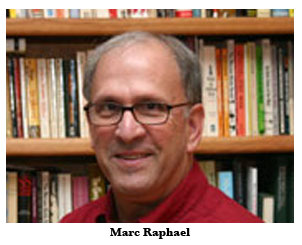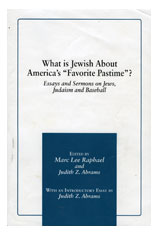Talking Judaism and baseball with Raphael
 When the weight of teaching about the
Holocaust begins to wear him down, Marc Raphael, it is said, retires to
the Major League Baseball box scores. Baseball is his refuge.
When the weight of teaching about the
Holocaust begins to wear him down, Marc Raphael, it is said, retires to
the Major League Baseball box scores. Baseball is his refuge.Raphael, the Sophia and Nathan S. Gumenick Professor of Judaica Studies at the College, calls himself “an enormous” baseball fan and “a walking encyclopedia” of the sport. “I spend most of my life going to baseball games,” he said. Baseball even played into his decision to become a rabbi. During a summer camp when he was a young boy, Raphael, confident in his ever-developing fastball, was pitching for the campers against the staff in a baseball game. After several decades, traces of astonishment still are evident in his voice as he recalls, “A rabbi on the staff stepped up to the plate and blasted a home run to win the game off of my blazing windmill fastball. Until then, I never had imagined that a rabbi could hit a baseball.” When it happened, Raphael says, becoming a rabbi became an option.
When he was growing up in Los Angeles, the Dodgers became his team. He still reflexively defends against those who nostalgically lament that the Brooklyn Dodgers should have stayed in the East. “People kind of think the Dodgers left at the peak of their popularity, but every single year the Dodgers attracted fewer fans in Brooklyn, so it was a simple economic decision,” he explained. Maury Wills remains his favorite player. “It’s a shame he’s not in the Hall of Fame, despite my letters,” he jokes.
Last semester, drawing on his love of the game, Raphael co-edited with Judith Abrams the book What is Jewish About America’s “Favorite Pastime”? The collection of essays expounds on numerous spiritual interpretations of baseball, many by rabbis who have used the game as a grand metaphor for helping to convey an understanding of the world.
 For
instance, in the opening piece, Hillel Goelman explores the correlation
of baseball to the mystical concepts of space (olam), time (shanah) and
the human soul (nefesh). Reuven Goldfarb and David Wechsler-Azen
consider the correspondence between the positions of baseball players
and sefirot (processess within God). In an essay titled “Jews on First:
The ‘Avot’ of Baseball,” Eric Schulmiller equates Jewish baseball
personalities with the great figures of Jewish history. “Lip” Pike, who
became the first “professional” player when he accepted $20 per week in
1866 to play for the Philadelphia Athletics, is Schulmiller’s Adam.
Barney Dreyfus, the owner of the National League Champion Pittsburgh
Pirates who in 1903 invited rivals from the upstart American League
championship squad to play an end-of-year series to determine the world
championship, is his Noah, the person who helped baseball enter its
modern age. (Dreyfus’ squad lost the series by 5 games to 3.) Henry
“Hank” Greenberg, the five-time All-Star, two-time American League Most
Valuable Player, four-time American League Home Run Champion who on
Sept. 19., 1934, in the midst of a pennant race took himself out of the
Detroit lineup in observance of Yom Kippur, is Schulmiller’s Abraham,
the baseball icon who came in “the middle of the generations.” Like
Abraham, Greenberg overcame many trials, the author writes, not the
least of which were the racial slurs and numerous slights that were
precursors to what Jackie Robinson, baseball’s first African-American
player, would face. Sandy Koufax, the six-time All-Star, holder of five
consecutive titles for earned-run average, pitcher of four no-hitters
and three-time winner of the National League’s Cy Young Award, is
Schulmiller’s Jacob, a person who “swindled many a batter out of his
birthright.” As did Greenberg, Koufax helped American Jews identify
with being Jewish and American when he refused to pitch in the opening
game of the 1965 World Series between the Dodgers and the Minnesota
Twins because it fell on Yom Kippur.
For
instance, in the opening piece, Hillel Goelman explores the correlation
of baseball to the mystical concepts of space (olam), time (shanah) and
the human soul (nefesh). Reuven Goldfarb and David Wechsler-Azen
consider the correspondence between the positions of baseball players
and sefirot (processess within God). In an essay titled “Jews on First:
The ‘Avot’ of Baseball,” Eric Schulmiller equates Jewish baseball
personalities with the great figures of Jewish history. “Lip” Pike, who
became the first “professional” player when he accepted $20 per week in
1866 to play for the Philadelphia Athletics, is Schulmiller’s Adam.
Barney Dreyfus, the owner of the National League Champion Pittsburgh
Pirates who in 1903 invited rivals from the upstart American League
championship squad to play an end-of-year series to determine the world
championship, is his Noah, the person who helped baseball enter its
modern age. (Dreyfus’ squad lost the series by 5 games to 3.) Henry
“Hank” Greenberg, the five-time All-Star, two-time American League Most
Valuable Player, four-time American League Home Run Champion who on
Sept. 19., 1934, in the midst of a pennant race took himself out of the
Detroit lineup in observance of Yom Kippur, is Schulmiller’s Abraham,
the baseball icon who came in “the middle of the generations.” Like
Abraham, Greenberg overcame many trials, the author writes, not the
least of which were the racial slurs and numerous slights that were
precursors to what Jackie Robinson, baseball’s first African-American
player, would face. Sandy Koufax, the six-time All-Star, holder of five
consecutive titles for earned-run average, pitcher of four no-hitters
and three-time winner of the National League’s Cy Young Award, is
Schulmiller’s Jacob, a person who “swindled many a batter out of his
birthright.” As did Greenberg, Koufax helped American Jews identify
with being Jewish and American when he refused to pitch in the opening
game of the 1965 World Series between the Dodgers and the Minnesota
Twins because it fell on Yom Kippur.Throughout the book, the “timelessness” of baseball, the game without a clock, and the ability of the the game to connect fans “from generation to generation” are recurring themes. In his essay, Jordan Parr alludes to the comparable rhythms of life and sport when he writes, “The Talmud is like a baseball game. It flows, back and forth, in gentle discussion. The debates are like a current; sometimes gentle, sometimes fast, but always moving in the same direction.”
Raphael approached Abrams about co-editing the book after he made two observations while attending Baltimore Orioles games in Camden Yards. One involved the fact that vendors were accommodating the dietary needs of Jewish fans by offering kosher foods; the other was an announcement on the scoreboard indicating the time and place were Jewish prayer services would be held.
“What struck me was this was such an amazing statement of the comfort level of Jews in America,” he said. “You can be Jewish and you can be American by your excitement over baseball. I would not use the word ‘assimilation’ because that would be to lose your identity. I’m talking about American Jews being comfortable in another culture.”
Raphael said he does not see “baseball through the lens of Judaism.” He never has prayed for someone to get a hit or for one team to win a game, he said. It is notable that Wills, his favorite player, was not Jewish. “I like the way he went about his work—the kind of way I have tried to model my professional life,” he explained. “He was very intense and very focused, and there never was a time when he gave less than 100 percent to his job.”
Raphael identifies two things he loves about the game: “One is the way that plays unfold and all of the different places that players move, not just the player to whom the ball is hit,” he said. “The other thing is that baseball is the one game that has no time limit. Things unfold in a leisurely way.”
Expounding on the movements of players, Raphael is intrigued by the way that many of the motions, for instance a catcher running down the first-base line after a bunt in anticipation of an errant throw, anticipates an error. “Errors are part of life,” he said. “I love watching a game and seeing how everybody moves around to anticipate something going wrong.” Although he would not elevate such a lesson to a faith issue, he does suggest that it could serve as a lesson for life—“kind of like driving defensively,” he said.
Another lesson for life involves The Natural, a book by Jewish author Bernard Malamud and subsequently a 1984 film released under the same name. “The much later Hollywood version of the story, with Robert Redford as the star, ends on the happy note of a killer home run that wins the championship, not the strikeout that leaves everybody lost, as in the novel,” Ori Z. Soltes explains in one of the book’s essays. Raphael suggests that Malamud’s version was more authentic. “One ending is more like life is and the other is more like Hollywood is,” he said. “Roy Hobbs’ entire life is one of loss and failure; it would have been kind of amazing if he had suddenly diverged from the path of his life. But we all come to those situations where we have some critical point, and we don’t always hit a home run.”














